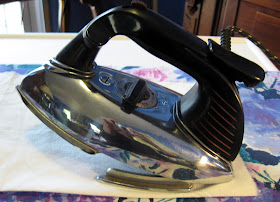Do you know the cheapo way of checking the alignment of the wheels on your car? Find a nice flat straight stretch of highway with no other cars in sight, and take your hands off the wheel. Does your car drive straight or pull to the right or left?
News flash: sewing machines don't have wheels. But when I was test driving the smackdown contestants one of them seemed to pull to the right, and the idea for this test was born. No I didn't mention this in the first smackdown post. Yes, I am making this up as I go. So if you have any ideas for testing sewing machines, send them in!
A VINTAGE IRON FOR VINTAGE SEWING

Vintage sewing deserves a vintage dry iron, and I have a dandy: a Proctor Never-Lift. This puppy weighs in at almost 5 pounds. Irons and cooking pots: the heavier they are, the better they perform.
This one has two feet that prop it up and a lever that locks them down. You don't have to pick the heavy iron up in between passes, just pop the feet up and that gets the hot surface up off the ironing board. No silly safety shut-off here: when it is on, it stays on. Forever. Until your house burns down.
If you are tired of spending big money on steam irons that don't last, search the thrift shops for a vintage dry iron and use a spray bottle of water.
(Check the wiring carefully, replace the cord if necessary or just wimp out and buy a NEW dry iron. But where's the fun in that?)
I got tired of replacing Rowentas every six months. Don't get me wrong, I really loved the massive steam of the Rowentas, that's why I kept buying them. But they all eventually leaked and spit and enough was enough. The Never-Lift cost $3 and should last a couple of decades, which should see me out.
THE PROCEDURE
I used the original straight stitch foot on each machine, but you can use any foot as long as you use the same type of foot on each machine.

Take an old sheet or other scrap material and cut or tear it into 12" squares. Fold each square in half so that you are sewing on two layers (to simulate actual sewing conditions). Iron them flat.
Position the folded cotton so that it lines up with any visible straight line edge, like where the machine body meets the cabinet or carrying case base. Start an inch in and hold on to the threads briefly to prevent any initial thread mess, but let go as soon as it takes a stitch or two. LET GO OF THE FABRIC and put the pedal to the metal and sew full speed to the other edge of the fabric. Compare your machines by measuring the drift to the right or left, if any.
SMACKDOWN TEST #1 RESULTS
Singer 15-91: Pulled 1" to the right
Singer 99: Pulled 4" to the right
Dressmaker 132: Pulled 3/4" to the right. THE WINNER OF ROUND 1.
ModernAge 250: Pulled 1" to the right
You are probably not planning on sewing hands free! So why this test? Some sewing machines feel as if they are cooperating with you, some feel as if they are fighting you. Some fight you tooth and nail. This seemed like one way to assess the "fight-you" factor.
Three of them drifted just slightly, while the 99 sent the fabric off at quite an angle. What does it all mean? Beats me. Do you have any ideas? The secret must lie in the relationship between the presser foot and the feed dogs
 |
| The Winner: Dressmaker 132 |
|
 |
| The Loser: Singer 99 |
This is the shakedown cruise for the 15, the 99 and the ModernAge, all of which have been acquired within the last two months. The 99 definitely has issues, which I will discuss in a future post. I may retest it after fiddling with it some more. The Dressmaker has been my go-to piecing machine for several years and I'll be singing its praises in another future post. Not surprised that it won Round 1 of the smackdown.
COMING SOON
The Cabinets: Originally I hadn't planned on reviewing the cabinets, but as soon as I sewed on them side-by-side I knew that this would be an important factor to consider and I will review them here.
The Stitches: I have started this, but soon decided that it would be a good idea to get a walking foot. Jenny at
Sew-Classic has them for straight stitch machines, and a zig-zag walking foot won't work properly on a straight stitch machine. She explains why
here. I ordered one last night.
Disclaimer: I have no relationship with Jenny at Sew-Classic except as a customer. She sells lots of great stuff for vintage machines and she provides a wealth of free information on repairs, parts, machine comparisons, threading guides, and more. She recently went out of her way to help me when I screwed up my order. Money is power and I believe in supporting businesses that add positive energy to the world.
The Machines: I will discuss each machine in some detail and describe how sewing machine acquisition is a similar to a love affair. It's cheaper and easier to come by, won't ruin your life and is disease-free too.
The DH claims that he reads my blog. Guess I will find out whether this is true or not!













